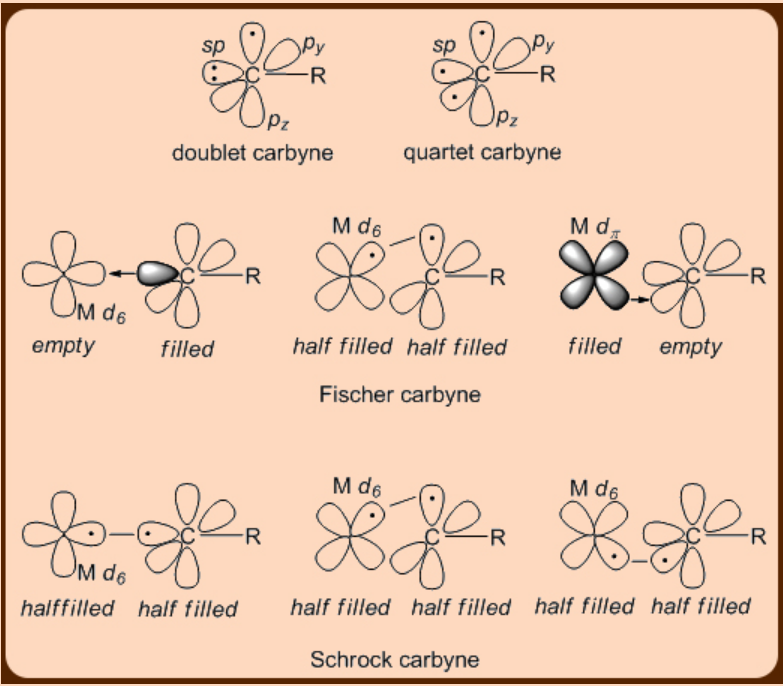13.2: Metal-Carbynes
- Page ID
- 172802
Learning Objectives
In this lecture you will learn the following
- The metal−ligand multiple bonding and their relevance in.
- The Fischer type carbyne complexes.
- The Schrock type carbyne complexes.
The metal−ligand multiply bonded systems even extended beyond the doubly bonded Fischer and the Schrock carbenes to the triply bonded LnM≡CR type Fischer carbyne and the Schrock carbyne complexes. Similar to carbene that exists in a singlet and a triplet spin state, the carbyne also exists in two other spin states i.e in a doublet and a quartet form.
Upon binding to the metal in its doublet spin state as in the Fischer carbene system, the carbyne moiety donates two electrons via its sp hybridized lone pair containing orbital to an empty metal d orbital to yield a LnM←CR type ligand to metal dative bond. It also makes a covalent π−bond through one of its singly occupied pz orbital with one of the metal d orbitals. The carbyne−metal interaction consist of two ligand to metal interactions namely a dative one and a covalent one that together makes the carbyne moiety a LX type of a ligand. In addition to these two types of ligand to metal bonding interactions, there remains an empty py orbital on the carbyne−C atom that can accommodate electron donation from a filled metal d orbital to give a metal to ligand π−back bonding interaction (Figure \(\PageIndex{1}\)).

Analogously, in the quartet carbyne spin state in the Schrock carbyne systems three covalent bonds occur between the singly occupied sp, pyand pz orbitals of carbyne−C moiety with the respective singly occupied metal d orbitals (Figure \(\PageIndex{1}\)).
Similar to what has been observed earlier in the case of the Fischer carbenes and Schrock carbenes, the Fischer carbyne complexes are formed with metal centers in lower oxidation states for e.g. as in Br(CO)4W≡CMe, while the Schrock carbyne complexes are formed with metals in higher oxidation state, e.g. as in (t−BuO)3W≡Ct−Bu.
Carbyne complexes can be prepared by the following methods.
i. The Fischer carbyne complexes can be prepared by the electrophilic abstraction of a methoxy group from a methoxy methyl substituted Fischer carbene complex.
\[\ce{L(CO)4M=C(OMe)Me + 2BX3 -> [L(CO)4M≡CMe]+BX_{4}^{-} + BX2(OMe) -> X(CO)4M≡CMe} \nonumber \]
ii. Schrock carbynes can be prepared by the deprotonation of a α−CH bond of a metal−carbene complex.
\[\ce{CPCl2Ta=CHR ->[(i)PMe3][(ii)Ph3P=CH2] Cp(PMe3)ClTa≡CR} \nonumber \]
iii. by an α−elimination reaction on a metal−carbene complex
\[\ce{Cp*Br2Ta=CHt-Bu ->[(i)dmpe][(ii)Na/Hg] Cp*(dmpe)HTa≡Ct-Bu} \nonumber \]
iv. by metathesis reaction
\[\ce{(t-BuO)3W≡W(Ot-Bu)3 + t-BuC≡Ct-Bu -> 2(t-BuO)3W≡Ct-Bu} \nonumber \]
The reactivities of Fischer and the Schrock carbynes mirror that of the Fischer and Schrock carbenes. For example, the Fischer carbyne undergo nucleophilic attack at the carbyne−C atom while the Schrock carbyne undergo electrophilic attack at the carbyne−C atom.
Summary
The theme of metal−ligand multiple bonding extends beyond the doubly bonded Fischer and the Schrock carbene systems to even triply bonded Fischer and the Schrock carbyne systems. The carbyne moieties in these Fischer and the Schrock carbyne systems respectively exist in a doublet and a quartet spin state. The carbyne complexes are generally prepared from the respective carbene analogues by the abstraction of alkoxy (OR), proton (H+), hydride (H−) moieties, the α−elimination reactions and the metathesis reactions. The reactivity of the Fischer and the Schrock carbyne complexes parallel the corresponding Fischer and the Schrock carbene counterparts with regard to their reactivities toward electrophiles and nucleophiles.


